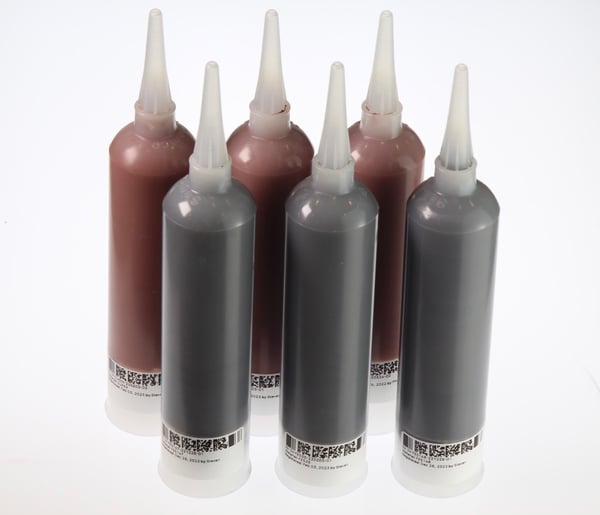PureForm™ photopolymer materials unlock metal DLP 3D printing
Holo’s PureForm metal additive manufacturing (AM) platform leverages two mature production technologies — digital light processing (DLP) 3D printing and backend sintering processes from the metal injection molding (MIM) industry — to produce complex, highly accurate, production-grade metal parts. Tying these two processes together and enabling this metal 3D printing technology are our proprietary PureForm materials, which combine DLP 3D printing-compatible photopolymers with the metal powder portfolio of MIM.
What is a photopolymer and why is it required for DLP 3D printing?
Photopolymers are a class of light-reactive chemicals whose properties change when exposed to a light source. In the context of DLP 3D printing, these are generally liquid polymers that harden via cross-linking and gain structural properties when an image is projected onto a volume or film of photopolymer by a digital projector.
Exposure of a photopolymer to a UV DLP light source to cure a layer, as part of a DLP 3D printing process
Photopolymers play a critical role in the DLP 3D printing process because they enable the printing technology to convert a high-resolution digital image composed of light into a high-resolution physical part.
Holo’s proprietary PureForm materials are composed of both photopolymers and metal powder designed for MIM, and are engineered to deliver reliable, accurate performance of the PureForm metal AM process.
What’s in Holo’s PureForm metal AM materials?
As a Holo customer, you can feel confident in the knowledge that metal parts you receive from us will be composed of exactly (and only) the metal you specified. For example, a PureForm 17-4PH stainless steel part is entirely composed of the 17-4PH stainless steel you’re used to, and adheres to industry standard compositional specifications.

17-4PH stainless steel and pure copper PureForm material cartridges ready for printing
To deliver those parts with high material purity however, our PureForm materials start as a metal 3D printing feedstock composed of a light-reactive photopolymer and MIM-grade metal powder of the specified alloy. Holo’s Materials team has spent intense efforts designing and engineering these materials to ensure that they have targeted viscosity and metal powder loading, low ash rate, and other critical properties that drive the success and quality of the metal 3D printing process.
How do Holo’s PureForm materials enable metal DLP 3D printing?
Before we dive into the mechanics of PureForm materials, it’s important to first understand how metal DLP 3D printing works.
Polymer DLP 3D printing is a popular 3D printing technology for complex plastic parts with tiny, intricate features because it’s fast, offers high resolution on even microscopic features, and can build parts with extremely smooth, high quality surface finishes. Metal DLP 3D printing on the other hand, is extremely rare, and it’s due to the fact that the DLP printing process by itself can’t create a solid metal part.
Instead, metal DLP 3D printing is actually a combination of two sequential processes: DLP 3D printing of a metal powder-filled photopolymer, which traps a uniform distribution of metal powder in the desired part geometry, and then subsequent MIM backend sintering, which removes the photopolymer and sinters the metal powder in the part together into its eventual final solid form.
Fully sintered PureForm pure copper parts being unloaded from a sintering furnace. These will then undergo final inspection before delivery.
In order to build high quality parts, PureForm materials consequently need to:
- have a high enough concentration of metal powder to form a high-quality solid part after sintering
- maintain a uniform distribution of metal powder throughout the printing process so that a ‘green’ (unsintered) part contains evenly distributed trapped metal powder
- cleanly vaporize the photopolymer binder without introducing impurities into the metal part during sintering
The details of how we achieve these goals are proprietary Holo trade secrets, but suffice to say that our PureForm materials demonstrate these properties, which is key to our PureForm metal AM platform consistently delivering True-to-CAD™ high accuracy metal parts with ready-to-use ultra-smooth surface finishes (2 µm Ra typical).
